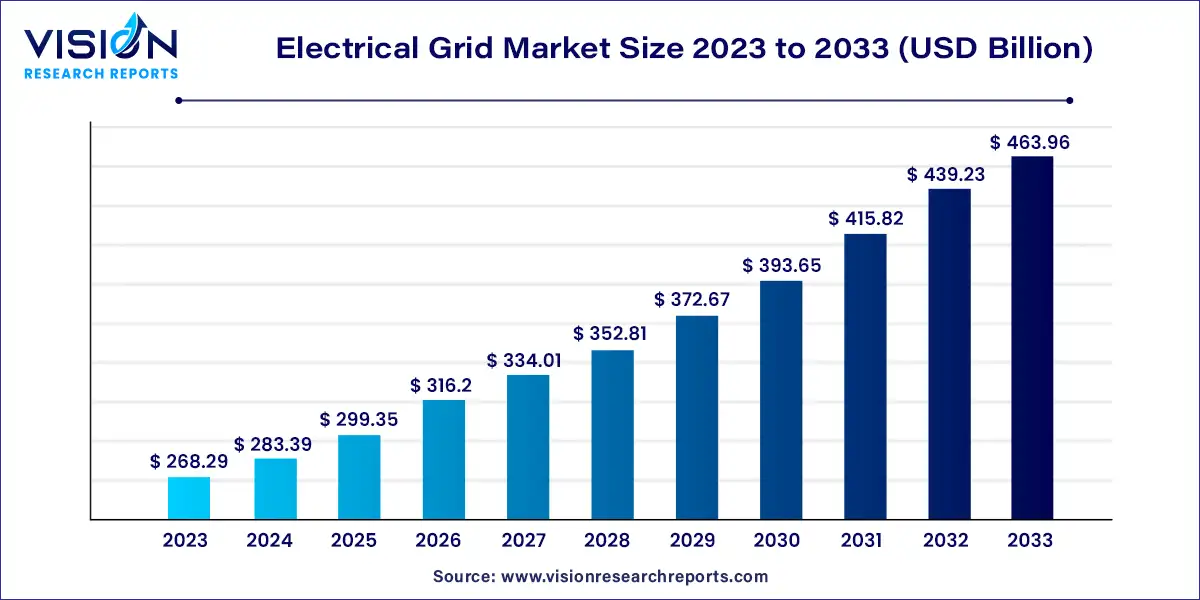The global electrical grid market size was estimated at around USD 268.29 billion in 2023 and it is projected to hit around USD 463.96 billion by 2033, growing at a CAGR of 5.63% from 2024 to 2033. The electrical grid market is a dynamic and rapidly evolving sector that plays a crucial role in the global energy infrastructure. As the backbone of electricity distribution, the electrical grid connects power generation facilities with consumers, ensuring a reliable and continuous supply of electricity. This market encompasses various components, including transmission lines, substations, transformers, and control systems, all working together to deliver electricity from producers to end-users.

The growth of the electrical grid market is driven by an including the increasing global demand for electricity due to population growth and industrialization, which necessitates the expansion and modernization of grid infrastructure. The integration of renewable energy sources into the grid is also a significant driver, as it requires advanced grid management systems to handle the variability and distributed nature of these energy sources. Additionally, technological advancements in smart grids and energy storage solutions are propelling market growth by improving grid efficiency, reliability, and resilience. Government policies and regulatory frameworks that support energy transition and grid modernization are further accelerating market expansion.
Renewables accounted for the largest revenue share, surpassing 31% in 2023. The growth of the renewables segment is anticipated to be driven by global efforts to reduce carbon emissions and the increasing cost-effectiveness of renewable energy technologies. This segment, which includes solar, wind, hydroelectric, and biomass energy sources, is crucial in the global shift towards a more sustainable and resilient energy system. Significant investments in renewable energy infrastructure, advancements in energy storage solutions, and supportive government policies are all contributing to the successful integration of renewables into the electrical grid.
On the other hand, the coal segment is expected to see a gradual decline in its share of the electrical grid market. While coal infrastructure remains in use in several countries, the industry faces growing challenges, including stricter environmental regulations, the competitive pricing of renewable energy, and increasing concerns over the health impacts associated with air pollution. This shift away from coal reflects a broader trend in the energy sector, prioritizing the reduction of carbon footprints and mitigating the effects of climate change.
The generation segment accounted for over 40% of the overall electrical grid market revenue. The generation segment, which includes power generation, transmission, and distribution companies, relies on electrical grids to enhance operational efficiency and reliability. The ability of electrical grids to handle high voltage conditions and perform well in switching and controlling electrical loads makes them essential to these operations. The ongoing investments in grid modernization and the growing focus on integrating renewable energy sources are expected to drive the growth of this segment.
Transmission involves the high-voltage transportation of electricity from power plants to substations near populated areas. This segment also includes the development, maintenance, and operation of long-distance transmission lines and towers. The transmission segment is increasingly focused on modernizing the grid by incorporating smart grid technologies to improve efficiency, reliability, and security in electricity transmission. Challenges such as aging infrastructure, rising demand, and the integration of renewable energy sources are fueling innovations and investments in this area to maintain a stable electricity supply.
North America Electrical Grid Market
The North American electrical grid market is characterized by efforts to modernize aging infrastructure and integrate renewable energy sources to create a cleaner, more sustainable power system. In both the U.S. and Canada, there is a strong emphasis on deploying modern technologies in smart grids, energy storage, and demand response programs to enhance grid reliability and manage the increasing electricity demand more efficiently.
Asia Pacific Electrical Grid Market Trends
The Asia Pacific region accounted for more than 45% of the global electrical grid market revenue. The region is expected to see increasing demand for electrical grid infrastructure, driven largely by rapid industrialization and urbanization in countries like China and India. Governments across the region are making significant investments in upgrading and expanding existing power infrastructure to meet the rising electricity demand from both residential and commercial sectors.
In India, the electrical grid market is expected to grow, propelled by the government’s ambitious initiatives to ensure reliable power supply across the country. The integration of renewable energy resources, particularly solar energy, is a key component of India's strategy to achieve energy self-sufficiency and reduce reliance on fossil fuels. For example, in February 2024, the Indian government announced the PM Surya Ghar scheme with an investment of approximately USD 8,955.0 million. This initiative aims to increase solar rooftop capacity, enabling residents to generate their own electricity.
Europe Electrical Grid Market Trends
In Europe, the European Union’s stringent regulations and policies promoting green energy have led to increased investments in renewable energy sources and the modernization of the electrical grid to support decentralized power generation. The focus on innovation, including energy storage technologies and the digitalization of the grid with advanced metering infrastructure, is expected to drive market growth in the region.
By Source
By Application
By Region
 Cross-segment Market Size and Analysis for
Mentioned Segments
Cross-segment Market Size and Analysis for
Mentioned Segments
 Additional Company Profiles (Upto 5 With No Cost)
Additional Company Profiles (Upto 5 With No Cost)
 Additional Countries (Apart From Mentioned Countries)
Additional Countries (Apart From Mentioned Countries)
 Country/Region-specific Report
Country/Region-specific Report
 Go To Market Strategy
Go To Market Strategy
 Region Specific Market Dynamics
Region Specific Market Dynamics Region Level Market Share
Region Level Market Share Import Export Analysis
Import Export Analysis Production Analysis
Production Analysis Others
Others